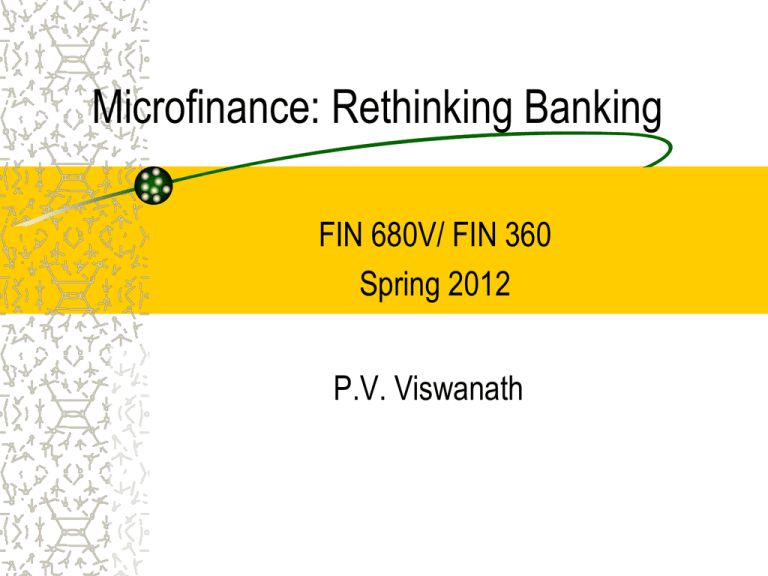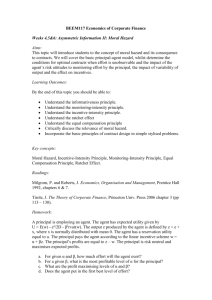The Returns to Acquiring Privately Held Firms: Costly Value Addition
advertisement

Microfinance: Rethinking Banking FIN 680V/ FIN 360 Spring 2012 P.V. Viswanath Primary Issues Loans are so small that profits are difficult to obtain. Lending is risky since the borrowers are too poor to offer collateral. Potential need for subsidies. Potential large positive impact on society. Locations Bangladesh, India Bolivia, Mexico Indonesia Bosnia Inner-city Los Angeles, outskirts of Paris, Queens Diminishing Marginal Returns to Capital The principle of Diminishing Marginal Returns to Capital says that “enterprises with relatively little capital should be able to earn higher returns on their investments than enterprises with a great deal of capital.” Implies that poorer enterprises should be able to pay banks higher rates of interest than rich entrepreneurs. Money should flow from rich depositors to poor entrepreneurs. Example of the tailor who can reap very high returns with his first investment in a sewing machine. Subsequent investments in a set of electric scissors would yield a lower return. Marginal Returns to Capital Marginal return for rich entrepreneur Output Marginal return for poorer entrepreneur Capital Diminishing Marginal Returns to Capital Capital should flow from rich to poor borrowers within any given country. But this is not so in practice…. Why are investments in fact far more likely to flow from poor to rich countries, and not in the other direction? Why do large corporations have an easier time obtaining financing than self-employed cobblers? Reasons for “perverse” flow of capital Higher risk – Investing in rural India or Kenya or Bolivia is much riskier than investing in the US But are the risk-adjusted returns high enough? Maybe they are, but usury laws prevent charging high rates. If so, the problem is entirely political. Or is it? Market Frictions Incomplete information – Adverse selection This problem exists before the parties contract – Moral hazard This problem is after the parties contract Lack of collateral Weak judicial systems make contract enforcement difficult. Hence, higher rates may reduce incentives to repay loans – and this may be crucial when there’s no collateral and good legal systems for forcing payment may not exist plus monitoring may be expensive. Incentive Problems Adverse selection: One of the parties to a transaction lacks information while negotiating. – An example of adverse selection is when people who are high risk are more likely to buy insurance, because the insurance company cannot effectively discriminate against them, usually due to lack of information about the particular individual's risk but also sometimes by force of law or other constraints. Moral hazard: The ignorant party lacks information about performance of the agreed-upon transaction or lacks the ability to retaliate for a breach of the agreement. – An example of moral hazard is when people are more likely to behave recklessly if insured, either because the insurer cannot observe this behavior or cannot effectively retaliate against it, for example by failing to renew the insurance. Both issues are incentive problems and both have to do with lack of information; adverse selection manifests itself prior to the contract and moral hazard subsequent to the contract. P.V. Viswanath 9 Moral Hazard What moral hazard problem is induced by the Federal Reserve bailing out banks? Is there a moral hazard problem when the Federal Government helps people affected by Hurricane Katrina? Is there a moral hazard problem when the government helps people who can’t make their mortgage payments because they have lost their jobs? How would you deal with these situations? In these cases, one party is unable to commit to taking certain actions. P.V. Viswanath 10 Principal-Agent Problems Principal-Agent problem: A special case of the moral hazard problem is when one party (the agent) undertakes to act on behalf of the other (principal). However, if the agent cannot be costlessly monitored, s/he might act in his own interests and to the detriment of the principal. – An example is when managers might act too conservatively because they don’t want to lose their jobs if the business fails – and they turn down risky, but profitable investment opportunities P.V. Viswanath 11 Financial System Solutions Moral Hazard – Managers could be given shares of stock or stock options to give them incentives to act like stockholders. – Collateralization of loans reduces the incentive for borrowers to act in a risky fashion since they would lose their collateral. – The existence of liquid markets for collateral then allows lenders to dispose of the collateral. Markets for collateralized assets also allow them to keep track of the value of the collateral. Adverse Selection – Banks cultivate long-term relationships with their clients making it less risky for clients to share sensitive information with the banks and allowing banks to price risk in a more informed fashion. – Firms can signal using mechanisms such as dividends and capital structure to reduce the adverse selection problem in the sale of securities. – Firms can signal quality through the offering of guarantees; this reduces the adverse selection problem in the sale of products/services. P.V. Viswanath 12 State Intervention as Solution Traditional solutions: – Moneylenders, friends, neighbors, relatives, local traders. Problem: insufficient funds The state can provide subsidies to reduce interest rates. State intervention often politicizes the process. When interest rates are not allowed to reflect costs of financial intermediation, wealth and political power replace profitability as the basis for allocating credit. IRDP Program in India Improper incentives for the financing organization. According to a 1989 study, IRDP Repayment rates fell below 60 percent and just 11 percent of borrowers took out a second loan after the first. In 2000, the loan recovery rate fell to 31 percent! Subsidizing banks can make banks flabby by creating banks and removing market tests. Problems with State Intervention Subsidized banks drove out informal credit suppliers. Market interest rates are not available as a rationing mechanism. Bankers’ incentives to collect savings deposits from the area are diminished by the flow of government capital – poor people had no way to save. State banks were pressured to forgive loans before elections, to give loans to the politically powerful, no incentives to create efficient organizations. Microcredit to Microfinance Microcredit originally meant a focus on getting loans to the very poor. The focus was on poverty reduction and social change. The push to microfinance came with the recognition that households can benefit from access to financial services more broadly defined (e.g. savings and insurance) and not just credit for microenterprises. Borrowing and Saving Why microfinance can not simply be about microcredit: Households borrow and save simultaneously. Borrowing and Saving are complementary activities. – The ability to borrow in a pinch can be critical in keeping saving strategies from becoming derailed. – In theory the poor can save over a period and time and use it for microenterprises. – In practice, household and community demands often use up saved funds; also, individuals have weak internal selfcontrol mechanisms. Differential Marginal Returns to Capital There may be yet another reason for the perverse flow of capital from poor to rich countries. The production function may not be concave everywhere. Marginal return for richer entrepreneur O u t p u t Marginal return for poorer entrepreneur Capital O u t p u t Marginal return for richer entrepreneur Marginal return for poorer entrepreneur Capital Usury? If marginal returns to capital are high, then the poor should be able to pay higher rates of interest. However, capital may be complementary with other inputs such as business savvy, commercial contacts, education levels etc. Hence the marginal return to capital may be lower for poorer entrepreneurs. Alternatively, returns to capital may be concave over some ranges and convex over others. Thus at a certain stage, the tailor might be able to expand by buying machines that allow him to tap into more profitable markets for more sophisticated and complicated clothing. In this case, high interest rates might freeze out some entrepreneurs. Are subsidies necessary? Some microfinance organizations have stayed at the NGO level and have depended on subsidies. Others, like Banco Compartamos have made large bond issues and even a public stock offering. IFMR has been an innovator in procuring market financing for microfinance, in India. It is possible that more traditional NGOs cater to a different and poorer clientele than larger profitminded microfinance enterprises. Issues for discussion Joint Liability Groups Dynamic Incentives Looser definitions of collateral The role of gender Social Impacts of microfinance









